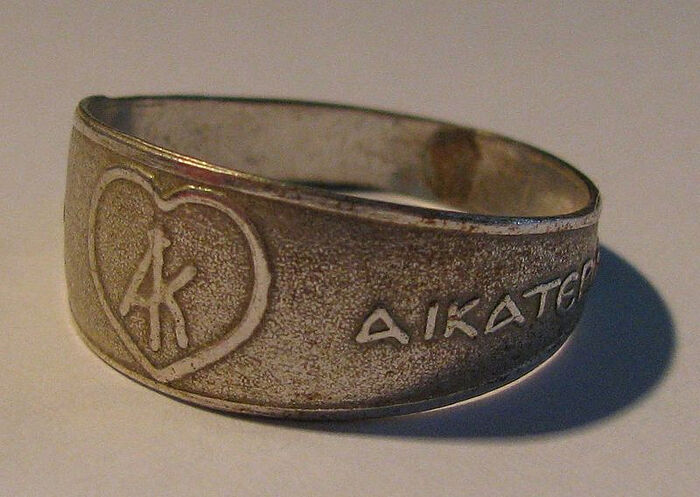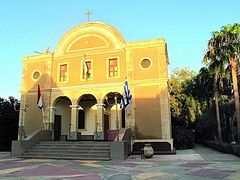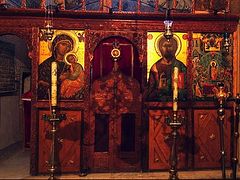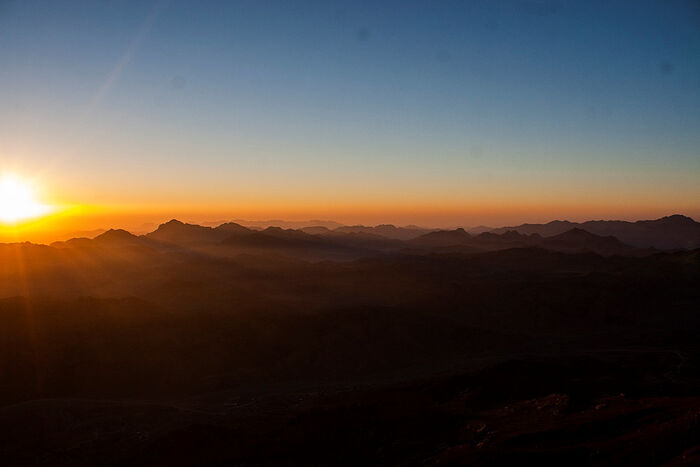 Dawn over Mt. Sinai transforms the whole mountain range
Dawn over Mt. Sinai transforms the whole mountain range
The Sinai Peninsula is a special point on the surface of the globe both for pilgrims desiring to touch the greatest shrines and tourists eager to see places that have been declared the heritage of mankind by UNESCO for their historical, artistic, and natural significance.
Seeing Sinai with your own eyes means seeing and feeling something that will be remembered for a lifetime. And if you manage to take photographs, your memories will be clearer, brighter and deeper. Our family archive contains photographs of Sinai—mine and those that my daughter took when she and her husband climbed the holy mountain of Moses. We all ventured to make that difficult pilgrimage when we were in Egypt. It was when there was no coronavirus yet and it was not so hard to get to the Sinai Peninsula.
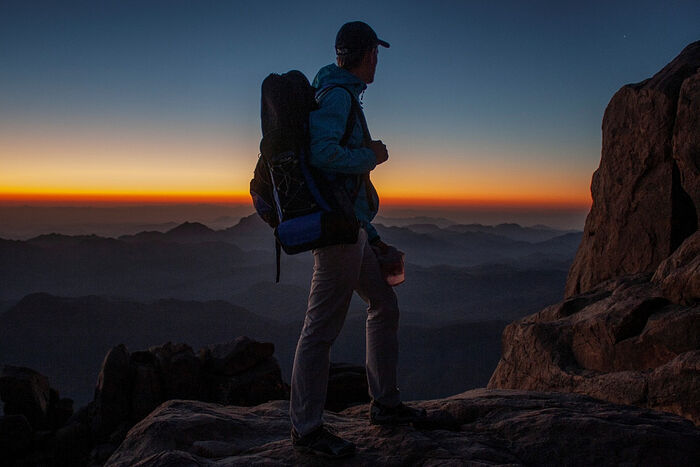 Sinai is a place of spiritual quest
Sinai is a place of spiritual quest
Many years have passed since then, but everything is remembered as if it were yesterday. Especially when you look at the pictures taken during those memorable travels or hear the names of the holy Prophets Moses and Elias and the Great Martyr Catherine, or think about the commandments of God.
***
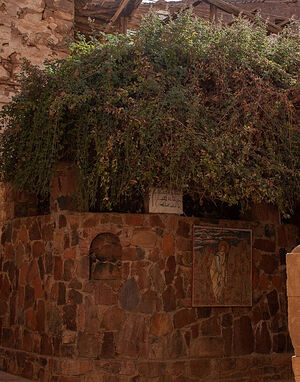 The Burning Bush: the bush that burned without being consumed Egypt is an ancient land of pyramids and pharaohs. Nowadays it is a state in which the overwhelming majority of inhabitants are Muslims. And yet, Egypt is also a land that has become famous for its many Christian ascetics and holy places.
The Burning Bush: the bush that burned without being consumed Egypt is an ancient land of pyramids and pharaohs. Nowadays it is a state in which the overwhelming majority of inhabitants are Muslims. And yet, Egypt is also a land that has become famous for its many Christian ascetics and holy places.
When a plane lands in Sharm El Sheikh, you find yourself on the Sinai Peninsula—that is, very close to Mount Horeb, or Mount Moses, which local Bedouins call Jebel Musa, considered by many peoples to be holy. It was here that the prophet received the tablets with the commandments from God Himself. It was through these desolate, sun-dried valleys of Sinai that the Jews walked from Egyptian slavery to the Promised Land. Here, at the foot of Jebel Musa, the Burning Bush still grows—the same one that was on fire but not consumed when God spoke with Moses. Here, on the slope of Mount Horeb, at an altitude of 5,150 feet, stands the Orthodox Monastery of St. Catherine—one of the most ancient in the world.
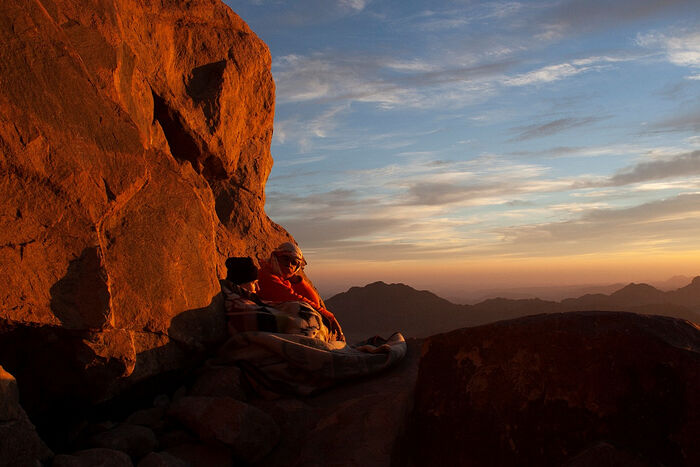 At the top many pilgrims wrap themselves in blankets
At the top many pilgrims wrap themselves in blankets
Mt. Sinai is inextricably linked with the names of many great saints. Back in the third century, attracted by the sanctity of this place, hermit monks began to settle in its caves. In 330, St. Helen, the mother of Emperor Constantine the Great, built a chapel over the roots of the Burning Bush, and this was the foundation of the future monastery. Its powerful, impregnable walls, reminiscent of a fortress rather than a monastery, were erected in the mid-sixth century by Emperor Justinian.
***
Climbing Mt. Sinai is possible throughout the year and always starts at night—it is too hot during the day, and the sunrise in the mountains is magnificent.
My pilgrimage began from St. Catherine’s Monastery, to which a minibus took us from Dahab through Egyptian military checkpoints. After that I went on foot.
I had a flashlight, warm clothes and provisions in a backpack carried by one of my companions—an experienced climber Sergei Sudnik. A young Bedouin guide showed me the way to the summit of Jebel Musa, which is 7,496 feet above sea level and a three or four hours walk.
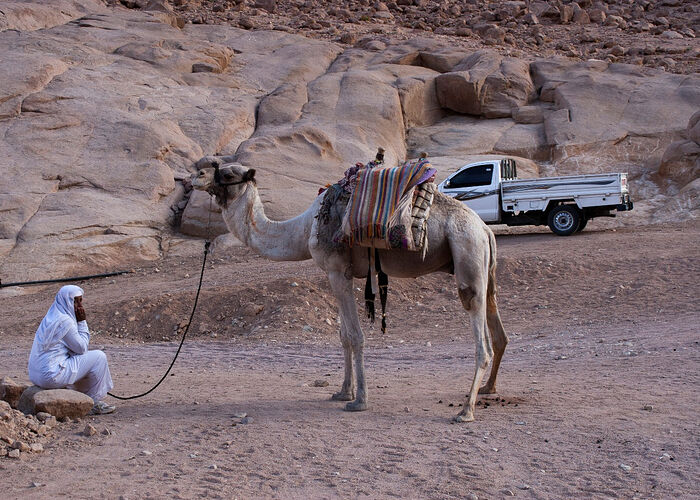 The Bedouin clothing, way of life, and other traditions have not changed for centuries
The Bedouin clothing, way of life, and other traditions have not changed for centuries
We walked in complete darkness. A flashlight beam lit up a scanty part of the path from the dark night—at least we could see where to step. The guide moved so confidently, as if he could see in the dark. We walked in silence. Occasionally we could hear from out of the darkness, “Do you need a camel?” I would point my flashlight and see camels lazily chewing their cud, and a Bedouin offering to drive us closer to the top. “No thanks. We have enough strength at the moment!”
Bedouins are amazing people—their appearance and their dwellings breathe hoary antiquity. Their clothing, way of life and traditions haven’t changed for centuries. They have only recently begun to use plastic and wear sneakers. Bedouins are Muslims, although they were Christians in ancient times. However, men of the Jebeleiah tribe still serve pilgrims going to Sinai and do various jobs within the walls of St. Catherine’s Monastery.
***
The starlight is so bright, as if the sky were very close. But there was no time to look at them yet. All attention was focused on the trail. The sky was getting closer; there was less energy and not enough air, and I was losing my breath. The climber advised that I shouldn’t take deep breaths, but breathe often and quickly. The lungs are ventilated better at high altitude. My body seemed to be getting filled with lead at each step. How hard it was! Oh, how I wished there were a camel there! But the gait of the Bedouin guide was still light, like a mountain deer. I asked him how often he climbed the mountain, and he replied, every other day. Wow! A true son of the mountains! He offered his hand, and, leaning on it, I overcame the last segment of the steep “staircase” without railings that lead to heaven.
***
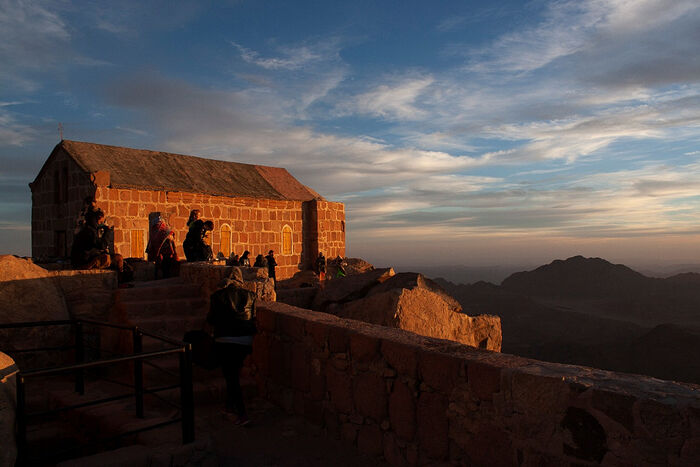 The Church of the Holy Trinity at the top of Mt. Sinai
The Church of the Holy Trinity at the top of Mt. Sinai
It was very cold at the top. The wind was piercing. Our guide suggested that we climb up some unstable structure into a crevice where the wind was faint—and disappeared. We hid and waited for the dawn.
We arrived on time—the sky in the east was just beginning to brighten. At every half second its color was changing. Light cirrus clouds were shimmering with indescribable shades of red, pink, gold, scarlet and dark red. The East was glorious! The world seemed to be born again before our eyes: And the evening and the morning were the first day (Gen. 1:5).
In my mind I said the shortest prayers: “Our Father”, “O Heavenly King.” I didn’t want verbosity and didn’t want to ask God for anything. Although many do the difficult climb to Horeb for the forgiveness of their sins. Lord, if only I could sense Thy presence in a thin small voice (1 Kings 19:12), as it was given to the Prophet Elias.
For some reason it was here, on Mt. Sinai, that the great and holy people Moses and Elias were vouchsafed to know the One God, to meet and commune with Him. This mountain has been sanctified more than once by the special presence of the Almighty. And we living in the twenty-first century want to see this place and participate in its mystical and Divine silence.
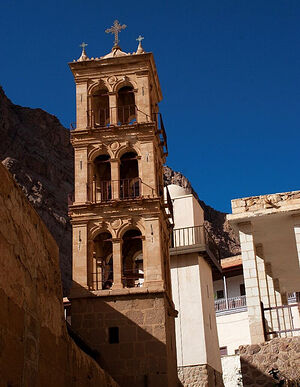 The bell tower of St. Catherine’s Monastery on Mt. Sinai A few hours passed, and below, next to the Burning Bush, where Moses was told: Draw not nigh hither: put off thy shoes from off thy feet, for the place whereon thou standest is holy ground (Exod. 3: 5), a guide who met us at the monastery, as if continuing my thoughts, said:
The bell tower of St. Catherine’s Monastery on Mt. Sinai A few hours passed, and below, next to the Burning Bush, where Moses was told: Draw not nigh hither: put off thy shoes from off thy feet, for the place whereon thou standest is holy ground (Exod. 3: 5), a guide who met us at the monastery, as if continuing my thoughts, said:
“Sinai is a place that symbolizes the inner path, growing up, meeting with its depth as a Divine image, meeting with God. Moses met the Living God, Who calls for movement, for dedicating one’s life to Him alone, and teaches us to live in trust and uncertainty. He showed the chosen people that He is both the King, the Lawgiver, the Judge, the Guide, and the Provider. Elias also sought God. He searched for Him in fire and strength, but the answer was in stillness, in weakness, in secrecy, in darkness, in solitude...”
***
Among the stones, on the terraces of the mountain, many people gathered from across the globe. Many were wrapped up in blankets. And Moses spent forty days and nights at the top without a jacket and blanket, without tea and provisions.
Dawn over Mt. Sinai transformed the whole mountain range. The sun brought warmth, light, joy, general animation and a completely new day. Cameras were clicking. I took pictures as well. Photos help preserve what memory misses.
I also bought a stone from the Bedouins. Outwardly it looked unremarkable and nondescript. I would never have guessed that inside it had a cavity with dazzlingly shiny crystals. These are the “Tears of Moses”. They say that these are frozen tears of the prophet who mourned the sins of his people. A beautiful legend... and an edifying one.
***
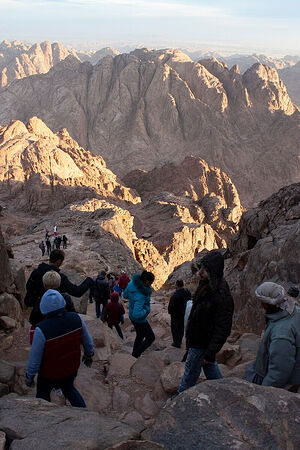 One wrong move and you can go tumbling down We began the descent. The stream of people, like a swift mountain stream, flew down to the foot of Jebel Musa. It seemed that it would be easier to go down. It was not so! If the way up partially consisted of stone steps, the shorter, “monastic” path, along which we decided to go down, consisted entirely of steps. But we didn’t know about it.
One wrong move and you can go tumbling down We began the descent. The stream of people, like a swift mountain stream, flew down to the foot of Jebel Musa. It seemed that it would be easier to go down. It was not so! If the way up partially consisted of stone steps, the shorter, “monastic” path, along which we decided to go down, consisted entirely of steps. But we didn’t know about it.
Incredible fatigue! Although during the ascent I had managed to nap for an hour in a Bedouin hut-cafe, now I was terribly sleepy. Each step was over a steep cliff, one wrong move—and you could fall down. But God preserved us! Sunlight finally made it possible to see the mountain. Those reddish rocks, with their intricate shapes and gaps, seemed to have been carved by water, but there has never been a river here. This is the wind! Centuries of its hard work have turned stones into finely carved sculptures. The shades of the stones are as if they had absorbed the color of the dawn.
***
A majestic view of the monastery opened before my eyes. Its small community, consisting mainly of Greeks, is practically autonomous and independent—it is headed by the Archbishop of Sinai elected by senior monks and ordained by the Patriarch of Jerusalem. It has its own rule, ancient traditions, even coat of arms and flag! For the more than 1,400 years of the monastery’s history the spiritual, monastic life has never been interrupted here, and the Liturgy has always been celebrated.
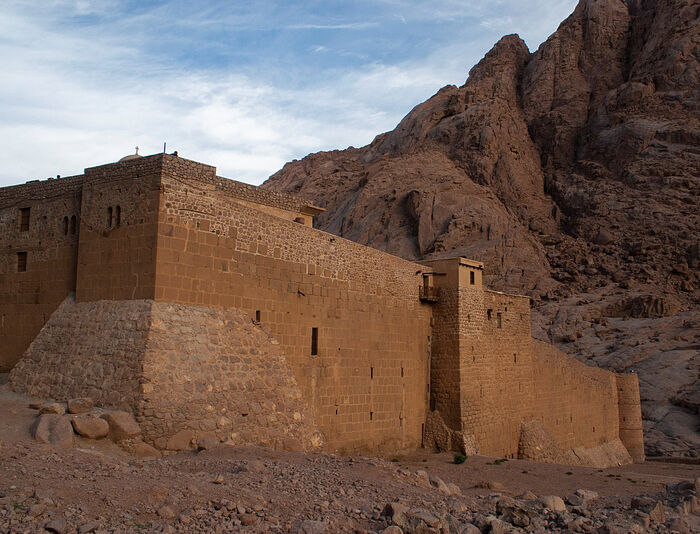 The mighty, impressive walls of St. Catherine’s Monastery!
The mighty, impressive walls of St. Catherine’s Monastery!
The walls of the monastery are impressive for their strength. Previously it was possible to get inside only by special elevators reminiscent of large birdhouses. People and food were lifted in baskets to a height of fifty feet. Now people enter through a narrow low door right below the elevator. We said goodbye to the Bedouin guide, and then we had a new guide—a Muscovite, Svetlana Folomeshkina.
***
Having passed the well of Moses, near which the prophet, according to legend, met his wife Zipporah, we approached the Burning Bush. I gazed at the sacred bush for a long time, trying to remember all the deep meaning and prototypes associated with it. There are so many of them! But the most important is the one associated with the Mother of God, the mystery of the incarnation of God through Her.
In ancient times the bush was transplanted a little to the side so the altar of the chapel built by the holy Empress Helen would be exactly above the site where God appeared to Moses—above the roots of the sacred plant. Botanists attribute it to the Rutaceae family. It is said to possess amazing properties. Its leaves and stem are dotted with glands that secrete essential oils. If you set fire to it, in calm weather it will flare up intensively, and for a moment the flames will evelop the branch without harming it.
I had no chance to visit the chapel that pilgrims enter without wearing shoes, remembering that Moses stood barefoot on this holy spot. But at the monastery everything is so holy and ancient that perhaps it is enough to put your hand to any stone to say: “I’ve touched a relic, I’ve been to the mountain where God spoke with man face to face!”
***
 We proceeded to the monastery’s treasury, where we admired the masterpieces of the art of jewelry for a long time—liturgical items made of precious metals and gems. But I was more impressed by the icons made in the encaustic technique. The whole collection is unique and priceless. The same can be said about the ancient manuscripts from the monastery library, which is considered the second largest in the world after the Vatican in terms of the number of collected books. This library contains the parchment sheets of the fifth-century Codex Sinaiticus —reputedly the oldest surviving manuscript with the Greek text of the Bible.
We proceeded to the monastery’s treasury, where we admired the masterpieces of the art of jewelry for a long time—liturgical items made of precious metals and gems. But I was more impressed by the icons made in the encaustic technique. The whole collection is unique and priceless. The same can be said about the ancient manuscripts from the monastery library, which is considered the second largest in the world after the Vatican in terms of the number of collected books. This library contains the parchment sheets of the fifth-century Codex Sinaiticus —reputedly the oldest surviving manuscript with the Greek text of the Bible.
Another unique document kept in the treasury is a copy of the security charter received by the monks in 623, sealed with an imprint representing Muhammad’s hand. The firman (pledge) reads that Muslims will protect the monastery from attacks and exempt it from paying taxes.
There is still a mosque on the territory of the monastery, erected at the beginning of the twelfth century so that the Bedouins working in the monastery could perform their prayers inside it. Close by stands a bell tower with nine bronze bells. We heard the ringing of one of them (this is a special privilege that monastery has, since in Muslim countries Christians are prohibited from ringing bells). This is a sign for pilgrims.
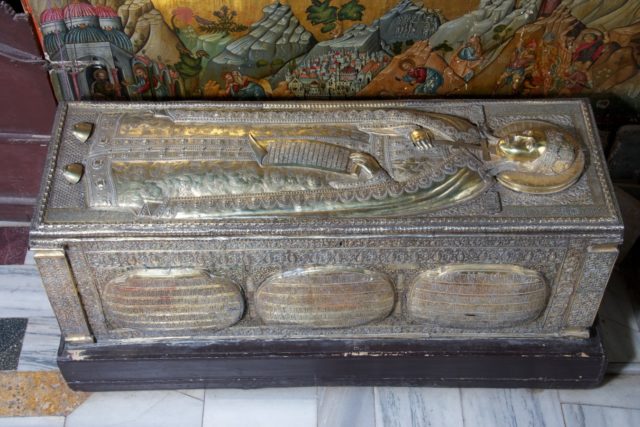 The chest with St. Catherine’s relics in Sinai
The chest with St. Catherine’s relics in Sinai
***
Svetlana invited us into the Church of the Transfiguration of the Lord. Though I could talk about this church for hours, this time I was particularly interested in St. Catherine’s relics. It is an intriguing fact that this monastery, originally called the Transfiguration Monastery or the Monastery of the Burning Bush, was renamed in honor of St. Catherine in the eleventh century.
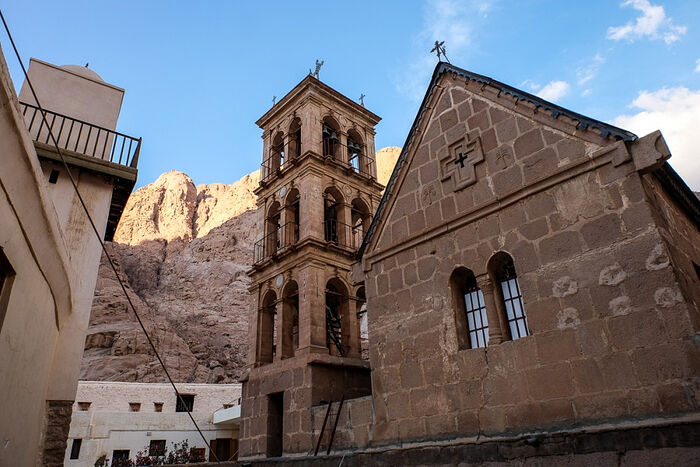 The Basilica of the Transfiguration and bell tower. Photo: Archpriest Igor Pchelintsev
The Basilica of the Transfiguration and bell tower. Photo: Archpriest Igor Pchelintsev
The head and left hand of the Great Martyr appeared at the monastery in an absolutely miraculous way. The holy maiden lived and was executed by pagans in Alexandria (on the other side of Egypt) in about 305. Three centuries later, following a revelation from above, the monks of the Sinai monastery found her holy body on the top of the highest mountain of Sinai, next to Jebel Musa.
Mount Sinai is the place where two great prophets sought God and met Him. And it is no coincidence that this holy place is also associated with the name of St. Catherine. Our guide Svetlana inspired us to reflect on this subject when she expressed an unexpected opinion:
“During her lifetime, St. Catherine had never been to Sinai and perhaps didn’t know about this place. It seems that she became connected with Sinai because she was internally connected with the events that had happened here.
“Here Moses and Elias sought the One Who is and always will be. And Catherine sought not only this, but also the Love that is and always will be. In this she was most likely the first.”
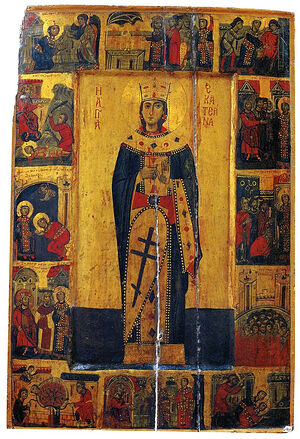 St. Catherine of Alexandria with scenes from her life After the pilgrims had venerated the Great Martyr’s relics, the monks gave each a silver ring with the monastery’s coat of arms and the words in Greek: “Αγία Αικατερίνη” (“St. Catherine”). I went up to the reliquary. An elderly monk with an infinitely kind smile gestured to me not to forget to lift the edge of my cap so it wouldn’t impede my kissing the reliquary. How much love and care was in his gesture! I venerated the reliquary, and a monk standing it beside handed me a ring.
St. Catherine of Alexandria with scenes from her life After the pilgrims had venerated the Great Martyr’s relics, the monks gave each a silver ring with the monastery’s coat of arms and the words in Greek: “Αγία Αικατερίνη” (“St. Catherine”). I went up to the reliquary. An elderly monk with an infinitely kind smile gestured to me not to forget to lift the edge of my cap so it wouldn’t impede my kissing the reliquary. How much love and care was in his gesture! I venerated the reliquary, and a monk standing it beside handed me a ring.
***
Photographs, a stone, and a ring. Such tangible, simple and precious reminders of the immaterial—of holy and mysterious Sinai. It is a place of spiritual quests, an austere mountain that awakens in people a thirst for truth and enlightenment, where an intense inner search leads to the podvig of self-knowledge, to a meeting with one’s innermost self, and God.




